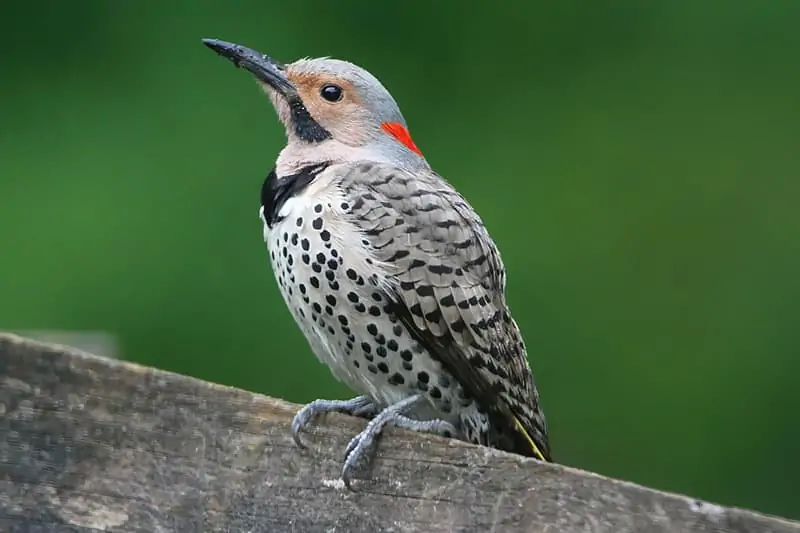The woodpecker family includes the Northern Flickers, who are some of the most fascinating. They are a favorite among backyard bird watchers because of their bold feather patterns and larger size. They’re common in open woods and human-inhabited places across North America, keeping bothersome bugs at bay. Learn some fascinating facts about Northern Flickers, as well as what makes them so distinct.
15 FACTS ABOUT NORTHERN FLICKERS
1. YOU CAN FIND THEM THROUGHOUT NORTH AMERICA AND SOME OF THE CARIBBEAN ISLANDS.
From California to New York, Northern Flickers may be seen throughout the year. During the warmer months, some populations move north to breed in Canada. In Mexico year-round, a group of Northern Flickers live.
In Cuba, as well as sections of Guatemala, El Salvador, and Honduras, Northern Flickers may be found.
2. SPECIES IN THE EAST AND WEST HAVE DIFFERENT COLORS
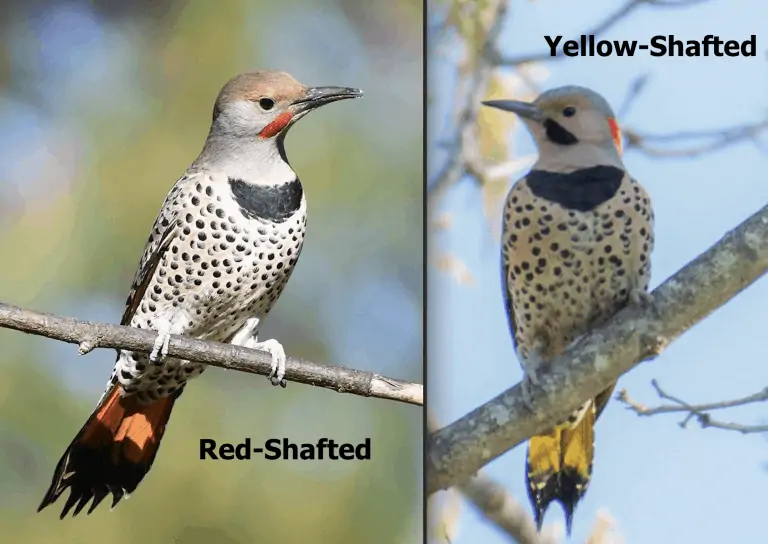
The underside of the wings and tail of eastern and western Northern Flickers are colored differently. The yellow-shafted variety is found in the east, and the red-shafted variety is found in the west. Unless the flicker has its wings or tail spread out, or you see them flying overhead, these colorful feathers may be difficult to detect.
There are a few more east-west distinctions. The eastern males have a black moustache, whereas the western males have a red moustache. In the east, the Flickers have a lighter brown body color, whereas in the west, it is gray. The barred back, patterned front, and black bib are all the same for both of them.
3. MALES AND FEMALES LOOK SIMILAR WITH ONLY A FEW DIFFERENCES.
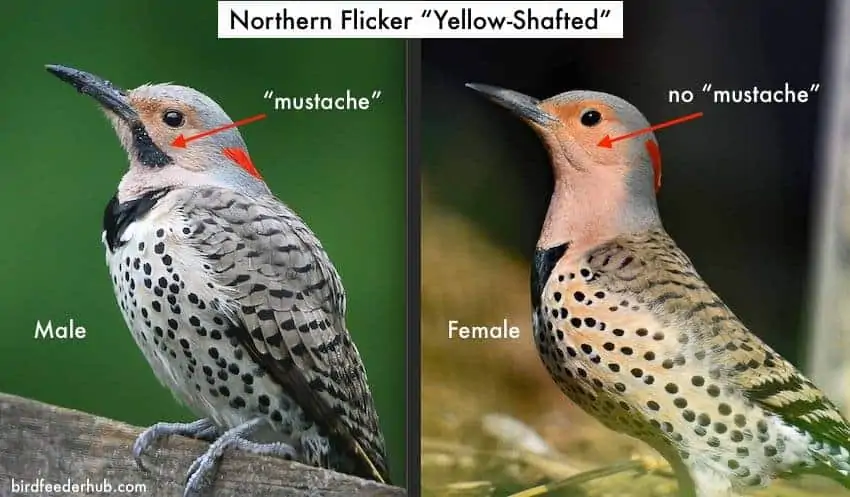
Northern Flickers have similar plumage in both sexes. They both have a U-shaped black patch on their breast feathers. They have black dots over their chest and belly, as well as black stripes on their wings. When in the air, a white patch appears over the tail. Both sexes have yellow on the bottom of their wings and tail, with red on the top for females in the east and blue for males in the west.
The male has a mustache or whisker on either side of its beak, which is the only obvious difference. This is black in the east and red in the west. This facial marking is not seen in females.
4. THEY EAT MORE ANTS THAN ANY BIRD IN NORTH AMERICA.
Northern Flickers are known as the “anteaters of the sky” because of their somewhat curved beak, which helps them find ants on the ground and around trees. In the stomach of a single Northern Flicker, one scientist discovered over 2,000 different species of ants!
5. THEY NEST IN DEAD TREES AND SNAGS.
Dead trees are preferred habitat for Northern Flickers. The trembling aspen, which rots easily and makes nest excavation easier for the Northern Flicker, is their favorite tree species.
They nest in different tree species, fence posts, telephone poles, and even house siding if those aren’t accessible!
Although it is not common, they occasionally nest in a hole in the ground. Custom-built nest boxes may also be used.
6. NORTHERN FLICKERS DON’T BUILD THE TYPICAL ‘NEST.’
A rotting tree is excavated from the inside by the mated pair, who create a single-entry hole. The tunnel extends under 6 to 18 inches and leads to a room where the female will deposit her eggs.
A compatible pair starts pecking away at the tender wood once they discover a suitable tree. Unlike many songbirds, the couple does not construct a nest inside the hollow using twigs or grass. The bottom of the hole is lined with only woodchips from their construction process.
Unlike other woodpeckers, Northern Flickers will reuse a tree cavity the next year.
7. PARENTS WORK TOGETHER TO INCUBATE THE NEST AND RAISE CHICKS.
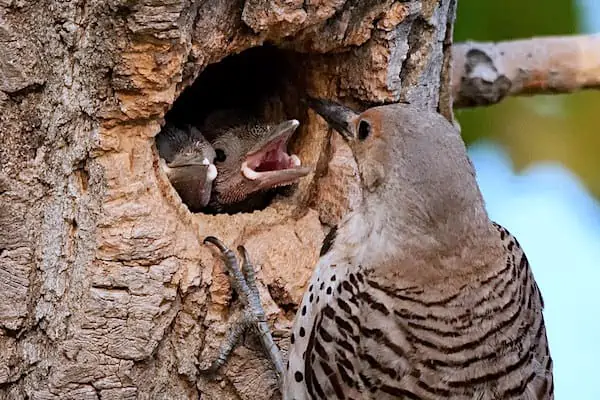
Parents of Northern Flickers are dedicated. The male and female dig the nest hole, incubate the eggs, and return food to the chicks. They even have a schedule!
Females incubate the eggs during the day, while males defend the nest, according to scientists. The roles are reversed at night.
8. THEY GET THEIR NAME FROM THEIR “FENCING DUELS.”
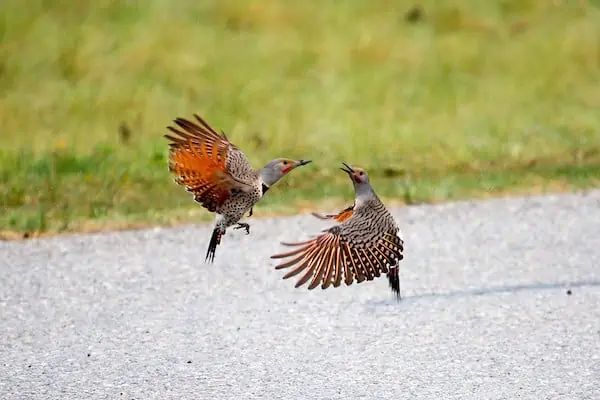
Males battle for the attention of females in the Northern Flicker, which is what gives it its name. They flap their wings open and shut, displaying their size and gorgeous plumage. They bob their heads and bodies in complicated patterns as well.
9. THEY LOVE ANY HABITAT WITH WOOD.
The Northern Flicker’s nesting habitat, food source, and resting perch are all in wood. An open grove of trees is where this bird likes to frequent. Foraging for insects on the exposed ground is a favorite activity.
If there are wooden structures that take their place, Northern Flickers will still live in areas without many trees. Fences, wooden building siding, and telephone poles are some potential alternatives. Northern Flickers will follow wherever there are insects.
10. MALE NORTHERN FLICKERS ARE TERRITORIAL.
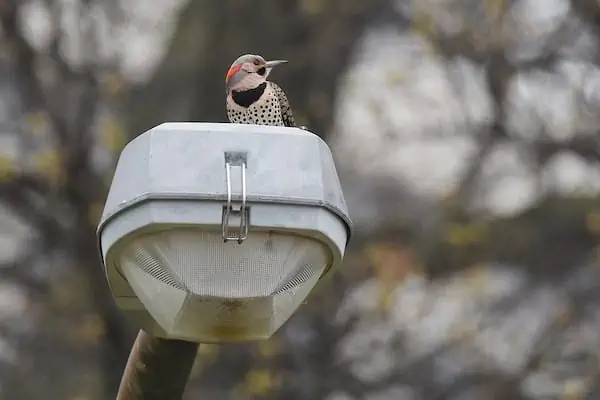
Even when it isn’t breeding season, Northern Flicker males compete with one another. While females watch, they participate in fencing duels throughout the breeding season. They also drum away at other territory and threaten others. The sound is made by a woodpecker repeatedly smacking its beak against a solid object (25 times per second). It seems to be a jackhammer, according to the majority of people.
11. THEY ARE ONE OF THE ONLY WOODPECKERS IN NORTH AMERICA THAT ISN’T BLACK AND WHITE.
Since they have brown feathers and forage for food on the ground, Northern Flickers are dubbed “the black sheep” of the woodpecker family. The dark brown hues of the woodland floor and their plumage aid them to blend in with the leaves. Most North American woodpeckers have black-and-white stripped feathers, which helps them blend in with tree bark.
12. NORTHERN FLICKERS’ TONGUE WRAPS AROUND ITS SKULL LIKE A FOOTBALL HELMET.
The tongues of Northern Flickers are specially suited to excavating insects out of tree holes and crannies. Their tongue evolved to wrap around their brain to reduce the risk of injuring it. The tongue protects the brain from injury when the bird pecks into a hole in a tree trunk at high speed.
13. NORTHERN FLICKERS FORAGE FOR FOOD ON THE GROUND.

Northern Flickers, unlike most woodpeckers, descend to the ground to search for food, rather than remaining high in the treetops or along the tree’s trunk. Ants are their favorite snack, and they can frequently be found here. They’re frequently seen digging in leaf litter or pecking the ground.
Their nests, which range from 6 to 15 feet in height, are nonetheless very close to the ground.
14. THEY EAT A WIDE VARIETY OF FOODS.

Northern Flickers eat fruit, seeds, nuts, and even snails in addition to ants. They aren’t afraid to dig through the dirt in search of insects hiding in deadfalls or rotting wood.
Northern Flickers will also devour juvenile bats, according to certain experts.
Northern Flickers will benefit from having suet out during the winter. Their usual diet includes a lot of protein. Suet may offer them additional nutrition during the winter months, since it contains more protein than most seed mixtures.
15. IT’S EASY TO SEE WHERE THEY’VE BEEN!
Throughout their travels, Northern Flickers leave signs of their hunt for food. They leave precise holes in trees, limbs, and even wooden siding that are difficult to overlook. They create dime-sized holes.
